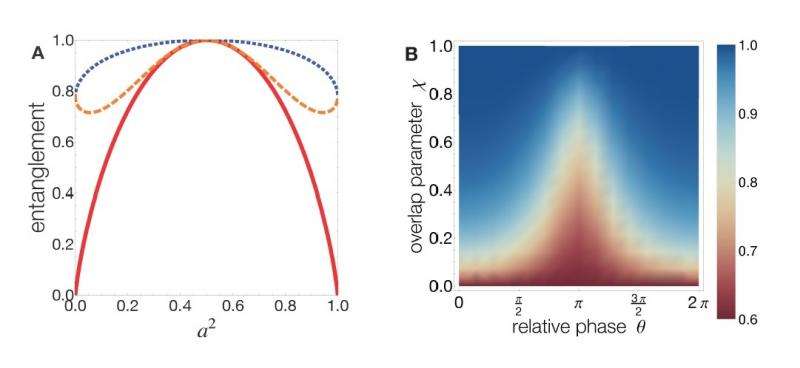February 9, 2016 report
Entanglement for identical particles doesn't follow textbook rules

(Phys.org)—In quantum entanglement, two particles are correlated in such a way that any action on one of them affects the other even when they are far apart. The traditional methods of measuring the degree of quantum entanglement were originally developed for nonidentical particles, such as between an electron and a proton, or two atoms of different types.
Unfortunately, these methods do not work very well when applied to identical particles, such as two electrons or two helium atoms, since such particles are indistinguishable. The traditional methods often give false positives for entanglement between identical particles, claiming that they are entangled even when it's clear that they are not.
Consequently, there is no general method for measuring the degree of entanglement between identical particles, although over the past several years physicists have made many attempts at developing such a method. However, these proposals often contradict the well-established methods, with some going as far as to redefine the very notion of entanglement.
Now in a new paper published in Nature Scientific Reports, physicists Rosario Lo Franco and Giuseppe Compagno at the University of Palermo in Italy have developed a method for measuring entanglement between identical particles that uses the same fundamental concepts as those used by the well-established methods for measuring entanglement between nonidentical particles.
In their paper, Lo Franco and Compagno propose that the root of the problem (why the traditional methods work so well for nonidentical particles but not for identical ones) is the general convention of labeling identical particles to make them appear nonidentical. Labeling can be done by, for example, by assigning a number to each particle.
"In quantum theory, identical particles are made nonidentical by naming them with unphysical labels," Lo Franco told Phys.org. "This procedure works well in the usual practice, except when correlation properties, like entanglement, for such systems are considered."
By doing away with the labels altogether, Lo Franco and Compagno could open a new avenue for investigating how indistinguishability impacts the degree of entanglement.
"A delicate yet strong aspect of our work is that it somehow defies some common beliefs and prejudices about this decades-long debated issue of the entanglement of quantum indistinguishable particles," Lo Franco said. "We show that identical particles can be treated without name labels, in contrast with the very usual textbook practice, maintaining a particle-based approach in terms of states. This enables the study of entanglement by means of the standard notions of entanglement theory for distinguishable particles."
The new approach finally provides an answer to the previously unanswerable yet basic question of whether or not two identical particles are entangled. The results reveal that, if two identical particles with opposite "pseudospins" (a property that does not make the particles different) are brought so close together that they begin to overlap each other in space, then they will become entangled. This theoretical result can help explain a recent experimental observation in which entanglement was generated simply by moving two ultracold rubidium atoms with opposite spins into the same optical tweezer.
The results also show that the degree of entanglement between identical particles depends on the degree of particle overlap, where particles that occupy the same exact space are maximally entangled. This relation between entanglement and overlap is unique to identical particles, as the entanglement of nonidentical particles does not fundamentally depend on particles occupying the same space.
In addition, the results show that the degree of entanglement between identical particles is always greater than that of nonidentical particles. This finding suggests that identical particles may be more efficient than nonidentical ones at becoming entangled, which has important implications for designing entanglement-based quantum information technologies.
Since overlap is a critical feature of identical particle entanglement, the results could lead to new experiments that use quantum correlations for quantum information tasks that are implemented in systems in which particle overlap is important. These systems include Bose-Einstein condensates, quantum dots, superconducting circuits, photons in waveguides, and aggregates of biological matter.
"Our work foundationally contributes to clarifying the relation between quantum entanglement and the identity of particles," Compagno said. "It also motivates studies that involve correlations other than entanglement. These areas have already been experiencing a huge amount of attention with nonidentical particles, but now we can investigate these correlations in the context of identical particles as well."
More information: Rosario Lo Franco and Giuseppe Compagno. "Quantum entanglement of identical particles by standard information-theoretic notions." Nature Scientific Reports. http://www.nature.com/articles/srep20603. On Arxiv: arxiv.org/abs/1511.03445
Journal information: Scientific Reports , arXiv
© 2016 Phys.org

















